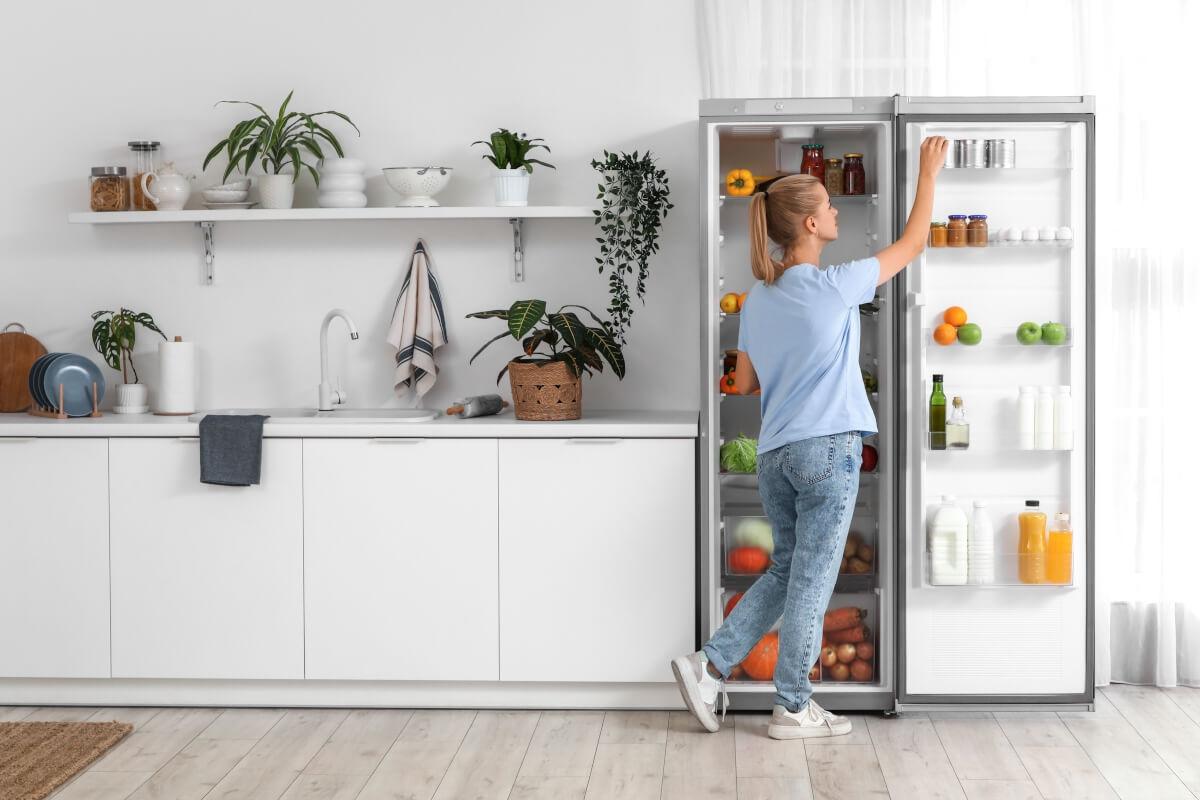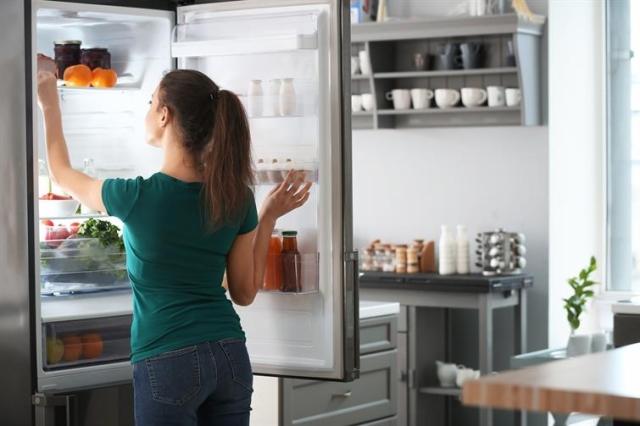When you’re hungry, the last thing you want to do is spend a long time searching for your favorite snack—only to find it’s spoiled rotten. An overcrowded or unorganized refrigerator can lead to forgotten foods, a lack of airflow, and spoiled food. If you’d like to avoid food waste, revamp your refrigerator’s organization. An organized refrigerator will help you save time and money, limit food waste, and spend fewer days finding unidentifiable leftovers. If you’d like to get started, here are some of the best ways to organize a refrigerator.
Clean Out Your Refrigerator

Similar to organizing other spaces in your home, the first step to organizing your fridge is cleaning it out. First, remove all items from the refrigerator and temporarily place them on a counter or in a cooler. Next, take inventory of all the food. Note how old fresh foods are, then check the expiration dates of all pre-packaged items. If any food has signs of mold, odor, or is expired, throw it away. If food is close to expiring but still safe to eat, consider placing it in the freezer for future use. Then, you can begin cleaning.
Use an all-purpose cleaner to remove any spills or sticky spots on the refrigerator’s shelves and surfaces. You can also use a mixture of hot water, vinegar, baking soda, and dish soap if you don’t have an all-purpose cleaner. Remove the drawers and let them soak in hot soapy water before wiping them down and placing them back inside. When you finish washing the shelves and drawers, wipe everything down with a paper towel or microfiber cleaning cloth before placing them back inside.
Afterwards, use a disinfectant to sanitize the refrigerator’s outer surfaces. If you own a stainless-steel appliance, use a specialized cleaner for extra shine. As a final step, add a deodorizer to the fridge. You can place a box of baking soda in the back of the refrigerator, stick small baking soda packets to the sides of the refrigerator walls, or purchase a scented deodorizer.
Finally, if you don’t use them already, consider adding liners on the shelves and drawers. Their wipeable surfaces are easy to clean and great for catching leaks and spills from food. The best options are ribbed plastic liners that help circulate air to prevent mold. However, if you’re tight on time or money, you can also use paper towels or kitchen towels.
How to Organize Your Refrigerator

Now that your fridge is sparkling clean, it’s time to place your food back inside. The key to an organized refrigerator is maintaining easy-access and safe storage of your food. Whether you’re sharing a fridge with a roommate or living alone, here are some of the best ways to achieve an organized fridge.
Organizing refrigerator shelves and doors
The key to organizing a refrigerator is grouping similar items by their food type and temperature requirements. Refrigerators are coldest near the bottom shelves, moderate near the middle and upper shelves and warmest on the door shelves. Remember which foods require specific temperatures when organizing your fridge.
First, place leftovers, drinks, dairy items, and ready-to-eat foods like dips and spreads on the upper shelves. As a rule, fruits, vegetables, and meats should be placed on lower shelves or in crisper drawers. Meat needs the coldest temperatures, so store it towards the bottom of the refrigerator or in the freezer. Putting it on the lower shelves also prevents potential leaks from contaminating your other foods. If you can’t place the meat on the lowest shelf, use a bin to catch any accidental leaks.
Contrary to popular belief, you should not place eggs and milk in the refrigerator door; both require cooler temperatures. Place milk, eggs, and other ingredients for cooked dishes on the middle or lower shelves.
Next, designate your door shelves for condiments. Group similar items together by reserving a shelf for sauces, a shelf for everyday condiments like mayo and mustard, and a shelf for specialty sauces and dips like pesto or cookie butter.
The final step to organizing your fridge is to place your go-to items together. For example, if you often eat peanut butter and jelly sandwiches, it is wise to keep those items together. Likewise, if you cook eggs every morning for breakfast, it is wise to keep your eggs in an easy-to-reach, temperature-safe place. Storing your food in a convenient yet safe area of your fridge is the best way to stay organized.
Fruits and veggies
Avoid placing fruits and veggies in the same drawer if you can swing it. Many fruits produce ethylene, a gas that causes other fruits and veggies to ripen faster. Thus, you should attempt to avoid placing fruits and vegetables in the same drawer. While apples, mangoes, stone fruits, pears, and kiwis produce ethylene, some exceptions—like strawberries—can be placed in the veggie crisper.
When storing vegetables, they often last longer if you place them in perforated reusable plastic bags or in the veggie crisper. While washing vegetables tends to spoil them quicker, you can prewash and precut your produce for quick, easy snacking.
Finally, learning how to use your humidity controls will also help prolong the life of produce. You should place perishable foods and ethylene gas-emitting fruits in a low humidity drawer. Likewise, place leafy greens like kale and spinach in a high humidity drawer. If your refrigerator does not have humidity controls, don’t fret. Along with specialized food storage containers, refrigerator deodorizers can remove ethylene gas so your produce will last longer.
Invest in food storage containers
Food storage containers can help preserve food and make your refrigerator more visually appealing. To store small snacks for easy access, use acrylic baskets. Opt for clear bins, large trays, or lazy Susans to store large items. Although you should avoid placing fruits and vegetables together, separate them with acrylic drawer dividers if you’re limited in space. Can-dispensers can optimize space by stacking beverages, and glass mason jars, plastic bags, and glass containers are great, multi-purpose ways to store liquids, snacks, or lock away pungent foods like onions or garlic.
Label everything
Labeling items in your fridge can help you maintain an organized fridge. You’ll see what you need to stock up on and which foods or leftovers you must consume first. You can use a marker on a zip-top bag or tape to write what the item is and the date. If you prefer a nicer aesthetic, you can use printed labels or an erasable marker on glass containers.
Decorate the Outside of Your Fridge

Now that you have an organized fridge, it’s time to personalize the outside of your fridge because it deserves attention as well. Use magnets, a small chalkboard, decals, or photos to decorate the outside of the fridge. If you ask your landlord for permission, you might be able to adorn your refrigerator with removable wallpaper for a unique look. Get creative or look up decoration inspiration online for more ideas. Your refrigerator will be organized and visually appealing in no time.
Organize Your Accommodations with Apartments.com
The first step to reorganizing a refrigerator is renting an apartment with one! Not all apartments feature the same amenities, and with Apartments.com, you can search for the appliances you need. Filter your search based on apartment amenities—such as a washer and dryer, dishwasher, or refrigerator in-unit. And once you find the perfect place? Use our platform to check if utilities are included. We have the tools you need to find the apartment you’ll love. Reorganize your refrigerator—and your residence—with Apartments.com.






